Malaysia
Caribbean Destinations | Pacific Destinations | Indian Ocean Destinations | Pacific Newsletters | Indian Ocean Newsletters | Flora and Fauna
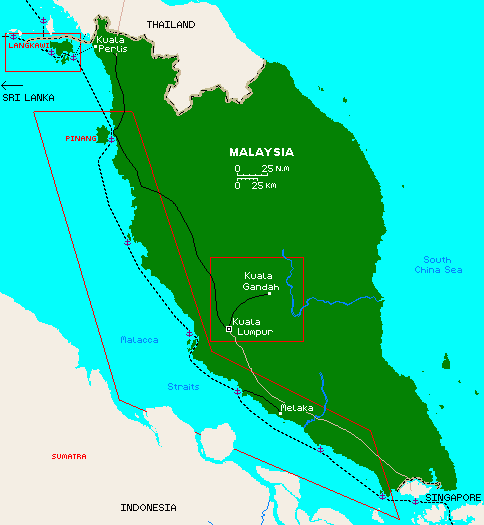 Language: Bahasa Malay and various Chinese languages. English is widely spoken.
Language: Bahasa Malay and various Chinese languages. English is widely spoken.
Population: About 23 million, with 85% living on the Malay Peninsula,
the remainder in Malaysian Borneo. 57% are ethnic Malay, 27% Chinese, 8% Indian.
The State religion is Islam, but religious freedom is guaranteed.
Money: About 3.8 ringgit (RM) per US$1 in 2006
Landscape: Peninsular Malaysia is well within the tropics and hosts
patches of virgin rainforest, rolling hills where tea is grown and low, wet
plains in the South.
Visited: December 3-31, 2006. Plus a few days in February,
2007 on either side of our trip into Thailand.
History: The oldest human remains on the Malay Peninsula are those of
"Perak Man" believed to be about 13,000 years old, and genetically related to
stone-age people who migrated south from Thailand. Today's Malays are
related to people who came across the Strait from the Indonesian islands and
settled here between 1,500 and 500 BC. Descendants of the Proto-Malay
still live in the jungles of northern Malaysia.
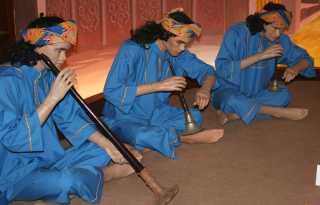
Wax figures of the Sultan's Royal musicians |
As early as the 2nd century AD, Europeans, Indians and Chinese
knew peninsular Malaysia for its gold and fragrant jungle hardwoods. Hinduism and
Buddhism were introduced by Indian traders, and there is much archeological
and linguistic evidence of the widespread influence of the Indians on this region.
From the 7th to the 13th centuries the peninsula was ruled from
Sumatra as part of the empire of Srivijayan. But Malaysia's own largest empire
was started by a renegade prince of that empire -- Parameswara. Caught between
the wrath of his own empire in Sumatra and the burgeoning influence of the
Thai/Chinese empires to the north, he sought to create a trading city in Melaka
(Malacca) under the mutual protection of India and China. Trade between the
two areas flourished with Melaka benefiting in the middle. On the backs of the
Indian traders, Islam was brought from India first to Sumatra, then to the the
Malay Peninsula. When the Sultan of Melaka converted, the religion spread rapidly.
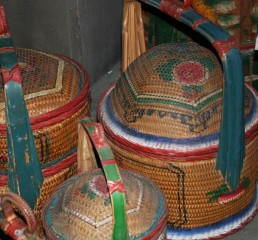
Beautiful Malay basketwork |
During the 15th century the Portuguese sought to cut out the middle
men in the spice trade and find a way to control the lucrative spice trade
directly. Claiming "God, Glory and Gold" they besieged the town of Melaka with
18 warships, defeating 20,000 local warriors and elephants. They built a
fortress, A'Fomosa, on a hill above the harbor (one piece of a wall of which stands
today) and from there ruled the seas and trade in the region for 130 years. It
was a tumultuous time as the Portuguese tried to instill Christianity in the
Muslim region and worked constantly for a monopoly in the spice trade. It was
the Dutch, interested not in glory or God, that routed the Portuguese from
Melaka in the mid 1600's. Although they took over the city of Melaka they did
not establish it as a Dutch trading center (they held Batavia -- now Jakarta,
Indonesia -- as their trading center until the early 1800's) but succeeded in
ridding the city of the Portuguese.
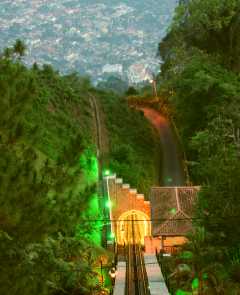
Penang, from British-era funicular |
In the late 1700’s the British arrived on the scene, with Francis
Light who settled on the island of Penang and set up a free trade zone which
prospered. Penang was virtually uninhabited at the time and under the auspices
of the Sultan of Kedah. During the Napoleonic Wars the British took over Dutch
interests in Melaka and Java, fearing the French influence would expand.
But with the fall of Napoleon, the British gave Java back to the Dutch.
Stamford Raffles, the British lieutenant-governor of Java, resented this move and
proposed that the British expand into the area South of the Malay Peninsula: the area
that became Singapore. The Dutch and British signed a treaty that gave Indonesia
to the Dutch and the Malay Peninsula and Singapore to the British.
Although Britain tried to maintain their mandate of “trade, not territory” in
Malaya, they had to step in to subdue some troubled sultanates in
the late 1800’s, promising not to interfere with religion or Malay customs. One
thing led to another and soon the British were ensconced in 4 Sultanates, each
presided over by a British Resident. Around the turn of the century most of the
remaining sultanates (those previously under Thai rule) also joined. From then
on, the British ran the economy of the Malay Peninsula, bringing in agricultural
workers from China, India and Ceylon (Sri Lanka) whose numbers soon equaled or exceeded
those of the native population of Malays. Four cultures and four religions began
to learn to live side-by-side: Christian European, Buddhist and Taoist Chinese,
Hindu Indians, and Muslim Malays.

Shoes for the bound feet of Chinese ladies |
World War II arrived on the Peninsula just hours before the bombing of
Pearl Harbor when the Japanese invaded the shores of Kota Bharu in NE
Malaya. Within a month Kuala Lumpur had fallen, and shortly thereafter,
Singapore, both of which were ruled harshly by the Japanese for 3 years.
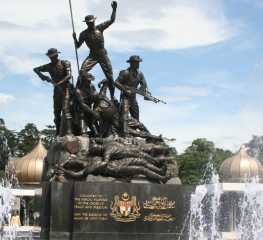
WWI & II memorial, Kuala Lumpur |
After the war the British began efforts to unite the Malay States into
a union, which was finally completed in 1948. But the Chinese population,
feeling they had gotten the raw end of the deal, was easy prey for the communist
movement and by 1948 a full-on guerrilla war was raging: Chinese vs. British.
The “Emergency” as the war was called, continued until 1960 when a British
military High Commissioner took control, moved half a million Chinese into New
Villages, and forced the communists north to the Thai border.
Meanwhile, moves for independence were underway, the trickiest part
being how to accommodate the ruler status of 9 sultanates. In an
original move, it was proposed that each Sultan rule for 5 years, then
rotate to the next in line, an unusual practice which continues today.
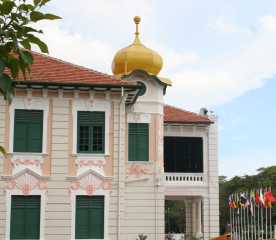
Independence memorial, Melaka |
Singapore was being pulled together by a left-leaning young politician named
Lee Kuan Yew and
Britain disliked the idea of having a communist state just to the south of
independent Malaya. In 1961 a Malay politician proposed merging Malaya and
Singapore (giving rise to the name “Malaysia”) a move which met with British
consent but in fact was a disaster. Racial problems escalated until the leaders
were barely talking and in 1965 Lee Kuan Yew pulled Singapore out.
Malaysia (the country kept the jointly-formed name for
themselves) had their own racial problems, with many years of injustice to
right: namely that the Malay people owned less than 3% of the industries in the
country. Economic parity (enforced by the government) was the goal and by the
1990’s a new Malaysian middle class had emerged. Today, Malaysia has thrown
off the yoke of agricultural export and become one of the major manufacturing nations
of SE Asia. It is a federation of 13 states with several political
parties, including a Chinese dominated democratic party and a fundamentalist Islam party.
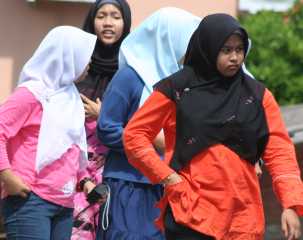
Young Malay women in Melaka |
(Sue) Malaysia from afar (and from an un-informed opinion)
conjured up images of a hot and steamy city (Kuala Lumpur) and dank small towns
typical of third world countries half a century ago. Surprised again! While it
was a bit hot and steamy everywhere there were air conditioned malls and offices
and lovely shade trees to cut the mid-day sun. As for Third World poor, I was
wrong. We experienced fancy long-distance bus rides, excellent roads, good internet
connections, great restaurants, safe public drinking water and modern malls.
Mostly, though Malaysia impressed me with its people. They were friendly,
smiling, courteous and helpful. We dressed conservatively to not give offense
with our Western garb, and I never felt unwelcomed by the people.
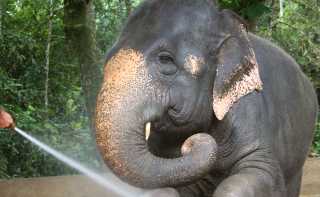
Malaysians & elephants: a long history together |
My rudimentary Bahasa Indonesia (almost identical to Bahasa Malay) was useful for
reading signs and greeting people, but I had trouble understanding the Malay
accent. This was probably because Bahasa Malay was many people's primary
language, while in Indonesia the people we met spoke Bahasa Indonesia as a
second language learned in school, so it seemed more simple and less fluent.
Another surprise was that I expected a fairly uniformly Muslim country. Wrong
again. The mixture of cultures is reflected in the shops, restaurants, shrines,
temples, mosques and churches that we visited. What a rich and varied
history/culture Malaysia enjoys!
(Jon) Like most of the places we've visited, I wish we
could have spent longer in Malaysia. Originally, I thought of Malaysia as
little more than a stepping stone on our way to (exotic) Thailand, but the more
we explored Malaysia, the more I liked it. The people were friendly, the
economy was vibrant, the prices were excellent, and the scenery was delightful.
Our trip into the interior was fun (long bus-rides notwithstanding) and our time
at the elephant sanctuary will be a memory I'll treasure. Definitely a
place we'll explore more the next time around...
Malaysia Pages:
Malacca Straits | Langkawi | Inland Malaysia
Related Pages:
Malaysia Home | Malay Newsletters | SE Asia Flora/Fauna | Cruising Malaysia
Indian Ocean:
Up | Indonesia | Singapore | Malaysia | Thailand | Nepal | India | Sri Lanka | Maldives | Chagos | Seychelles | Madagascar | Mayotte
Destinations:
Caribbean Destinations | Pacific Destinations | Indian Ocean Destinations | Pacific Newsletters | Indian Ocean Newsletters | Flora and Fauna
Top Level:
Home |
Destinations |
Cruising Info |
Underwater |
Boat Guests |
Ocelot |
Sue |
Jon |
Amanda |
Chris |
Site Map |
Make a Comment
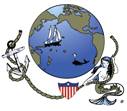 |
Lifetime
Commodores
of the
Seven Seas
Cruising
Association |
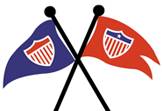 |
|
If our information is useful,
you can help by making a donation
|
Copyright © 2000‑ Contact:
Jon and Sue Hacking -- HackingFamily.com, svOcelot.com.
All rights reserved.
 Language: Bahasa Malay and various Chinese languages. English is widely spoken.
Language: Bahasa Malay and various Chinese languages. English is widely spoken.








